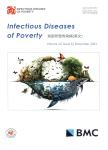Role of social organization engagement in high-risk groups intervention against HIV/AIDS:a case study from 176 cities of China
Role of social organization engagement in high-risk groups intervention against HIV/AIDS: a case study from 176 cities of China作者机构:School of Population Medicine and Public HealthChinese Academy of Medical Sciences&Peking Union Medical CollegeBeijingChina Chinese Preventive Medicine AssociationBeijingChina Zhejiang Chinese Medical UniversityHangzhouChina Centre for Health Management and Policy ResearchSchool of Public HealthCheeloo College of MedicineShandong UniversityJinanChina Chinese Academy of Medical Sciences&Peking Union Medical CollegeBeijingChina
出 版 物:《Infectious Diseases of Poverty》 (贫困所致传染病(英文))
年 卷 期:2022年第11卷第6期
页 面:70-83页
核心收录:
学科分类:1004[医学-公共卫生与预防医学(可授医学、理学学位)] 1002[医学-临床医学] 1001[医学-基础医学(可授医学、理学学位)] 100401[医学-流行病与卫生统计学] 10[医学]
基 金:Research on population medicine theory,XK-001-YWZ China AIDS Fund for Non-governmental Organizations,Disciplines construction project:Population medicine,Zhejiang Province soft science research program,2021C35013.
主 题:Social organization High-risk groups HIV/AIDS Spatial effect
摘 要:Background: A high-risk prevention strategy is an effective way to fight against human immunodeficiency virus (HIV) and acquired immunodeficiency syndrome (AIDS). The China AIDS Fund for Non-Governmental Organizations (CAFNGO) was established in 2015 to help social organizations intervene to protect high-risk populations in 176 cities. This study aimed to evaluate the role of social organizations in high-risk population interventions against HIV/AIDS.Methods: This study was based on the CAFNGO program from 2016 to 2020. The collected data included the number and types of social organizations participating in high-risk group interventions and the amount of funds obtained by these organizations each year. We explored the factors influencing the number of newly diagnosed AIDS cases using a spatial econometric model. Furthermore, we evaluated the effectiveness of intervention activities by comparing the percentages of the individuals who initially tested positive, and the individuals who took the confirmatory test, as well as those who retested positive and underwent the treatment.Results: Overall, from 2016 to 2020, the number of social organizations involved in interventions to protect HIV/AIDS high-risk populations increased from 441 to 532, and the invested fund increased from $3.98 to $10.58 million. The number of newly diagnosed cases decreased from 9128 to 8546 during the same period. Although the number of cities with overall spatial correlations decreased, the spatial agglomeration effect persisted in the large cities. Citywise, the number of social organizations (direct effect 19.13), the permanent resident population (direct effect 0.12), GDP per capita (direct effect 17.58;indirect effect -15.38), and passenger turnover volume (direct effect 5.50;indirect effect -8.64) were the major factors influencing new positive cases confirmed through the testing interventions performed by the social organizations. The initial positive test rates among high-risk populations were below 5.5%, the retesting rates among those who initially tested positive were above 60%, and the treatment rates among diagnosed cases were above 70%.Conclusions: The spatial effect of social organizations participating in interventions targeting high-risk populations funded by CAFNGO is statistically significant. Nevertheless, despite the achievements of these social organizations in tracking new cases and encouraging treatment, a series of measures should be taken to further optimize the use of CAFNGO. Working data should be updated from social organizations to CAFNGO more frequently by establishing a data monitoring system to help better track newly diagnosed AIDS cases. Multichannel financing should be expanded as well.



